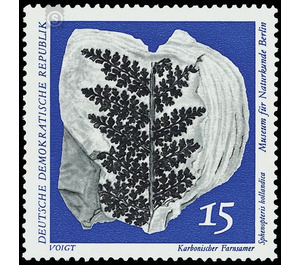Paleontological collections from the Museum of Natural History in Berlin - Germany / German Democratic Republic 1973 - 15 Pfennig
Theme: Architecture
| Country | Germany / German Democratic Republic |
| Issue Date | 1973 |
| Face Value | 15.00 |
| Color | grey blue |
| Perforation | K 13 |
| Printing Type | Photogravure |
| Stamp Type | Postage stamp |
| Item Type | Stamp |
| Chronological Issue Number | 1565 |
| Chronological Chapter | GER-DDR |
| SID | 755640 |
| In 30 Wishlists | |
Paleontological collections from the Museum of Natural History in Berlin The Ministry of Posts and Telecommunications of the German Democratic Republic publishes six multicolored special postage stamps depicting motifs of paleontological collections from the Museum of Natural History in Berlin. Paleontological collections from the Museum of Natural History Berlin The fossils from the paleontological collections of the Museum of Natural History Berlin on the special stamps are particularly valuable original witnesses of the history of life on earth. They are both research objects and simultaneously used illustrative material in the educational work of the museum. The Museum of Natural History Berlin - an institution of the Humboldt University - preserves, maintains and extends, among other natural history collections, the largest paleontological collection of the GDR with about 15 million objects. 15-Pfennig Fourth: Carboniferous fernsnamer, Sphenopteris hollandica; GOTHAN & JONGMANS Farnsamer are the oldest seed plants in the Earth's history and at the same time good examples of transitional forms in the evolution of land plants. With their mosaic-like combination of ancient (fern-like) leaves and advanced features (seed propagation), they represent the most important source group for all later seed plants. The Sphenopteris hollandica from the Namur B time of the Varistic Mountain Overseas is, like many other ferns, an important time marker ( Leitfossil) to the geological classification of rock series of Upper Carboniferous.


